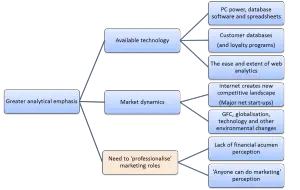Contents
Why the shift from art to science in marketing?
When you study marketing, often one of the early questions that are discussed and debated in lectures, is marketing an art or science?
Certainly in the earlier days of marketing, probably up until the 1980s or so, marketing would have been considered to be an art. By this we mean that the firm’s marketing strategy was typically built around a central communication message – probably quite creative in nature – and success of the firm rose and fell upon its execution of this creative message.
This was the era of big brand building via major TV advertising. A good example of this promotional era was the competitive style advertising and battle between Coca-Cola and Pepsi-Cola in the American soft drink market.
In recent years, however, the marketing profession has shifted towards a more analytical and scientific approach to its marketing activities. There are a numerous drivers for this change, including:
Available technology
The increase in computer capacity and data storage has dramatically increased the ability of marketers to analyze data. When you consider that personal computers, even in the workplace, or not widely available until the late 1980s, it is easy to imagine that a marketer of that era would have limited access to analytical information.
At that time, a marketer would have been relied upon submitting requests to the information technology area of them to run whatever reports may be available, as well as seeking information from the firm’s financial and accounting area. And unfortunately, in that era, request for marketing information was generally awarded with a lower priority than other requests.
Customer databases
With the shift of significant marketing activities into service firms, which typically deal directly with customers (as opposed to manufacturers of goods, who typically distribute via retailers) – the ability to capture customer information is now widespread and significant.
In past years, it was primarily direct marketers – typically via direct mail – who are able to build customer databases. Even most financial institutions, such as banks, have only converted their financial records of customers into a usable customer database since the 1990s.
These days many retailers operate loyalty programs, which allow them to capture data on purchases and transaction volume on a per customer basis. Many service firms also operate using customer details. This extra insight into how customers behave and how they respond to various marketing mix offers makes it far easier to analyze and become more marketing scientific.
Web analytics
Search engines like Google provide significant ability to analyze websites traffic and the behavior of users when using that website. This is broadened the understanding of analytics and has developed confidence among marketers that they can work with this style of data to help them with their day-to-day marketing activities, as well as communicating the success of their programs to senior management.
New competitive landscape
The degree of success of numerous Internet companies in particular, has highlighted the dynamic nature of business. For example, numerous industries – such as media, entertainment, banking, education and even shopping – have been transformed, in a relatively short time, by the Internet and the subsequent changes in consumer’s behavior.
This has had the impact of encouraging more traditional firms to be more dynamic in their approach to the marketplace – mainly because the marketplace is changing faster than ever. Generally, established firms, because they have more to lose, are more conservative in nature and typically seek out more analysis before making substantial strategic modifications.
As a result, greater market testing and experiments is required in previously more conservative and less dynamic large companies.
Rapid environmental change
In addition to competition increasing the volatility and the dynamics of most marketplaces, the broader environment is also changing faster. Like with competitive change above, it is becoming harder for firms to stick to their long-term strategy because of significant changes across the board.
Obviously there are significant changes in technology, in the importance of the natural environment, reasonable changes in the economic environment and the global landscape, and so on. These changes have the combined impact of needing firms to change and adapt, and therefore requiring them to undertake a greater degree of analysis and research.
The professionalism of marketing
There is a drive within the marketing profession itself to become more analytical and scientific, in order to transition to marketers being perceived as profit managers.. There are two fundamental issues in this regard. The first is that “Finance” is typically considered to be the common language of business. Unfortunately, from the previous generations of marketers who would typically more art based than scientific, a strong perception in the business community was formed that marketers lack analytical rigor and financial acumen. As a result, marketers are typically less represented at senior executive levels.
This lack of analytical rigor and more art based focus in the past, has also created the perception that “anyone can do marketing”. It is not uncommon for a non-marketing background executive to be put in charge of marketing for a couple of years while they are being groomed for a CEO role. Clearly, this would not happen in reverse to frequently – that is, a marketer being put in charge of the finance area, for instance.
Therefore, as a result of these historical perceptions, quite a number of people within the marketing profession are working hard to take a more analytical and marketing metric focused approach to the field of marketing.
The following diagram summarizes the various drivers that are pushing marketing towards a more scientific approach.

